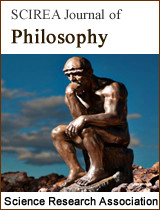The Validity of Generalized Modal Syllogisms with the Generalized Quantifiers in Square{most}
DOI: 10.54647/philosophy720087 29 Downloads 41992 Views
Author(s)
Abstract
Due to the large number of generalized quantifiers in the English language, this paper only studies the fragment of generalized modal syllogistic that contains the quantifiers in Square{all} and Square{most}. On the basis of generalized quantifier theory, possible-world semantics, and set theory, this paper shows that there are reducible relations between/among the generalized modal syllogism ⼞EM◇O-3 and at least the other 29 valid generalized modal syllogisms. This method can also be used to study syllogisms with other generalized quantifiers. The results obtained by means of formal deductive method have not only consistency, but also theoretical value for the development of inference theory in artificial intelligence.
Keywords
generalized modal syllogisms; reducibility; modality; validity
Cite this paper
Siyi Yu, Xiaojun Zhang,
The Validity of Generalized Modal Syllogisms with the Generalized Quantifiers in Square{most}
, SCIREA Journal of Philosophy.
Volume 4, Issue 1, February 2024 | PP. 11-22.
10.54647/philosophy720087
References
| [ 1 ] | J. Łukasiewicz, (1957). Aristotle’s Syllogistic: From the Standpoint of Modern Formal Logic, second edition, Oxford: Clerndon Press. |
| [ 2 ] | G. Patzig, (1969). Aristotle’s Theory of the Syllogism. D. Reidel. |
| [ 3 ] | P. Halmos, (1974). Naive Set Theory, New York: Springer-Verlag. |
| [ 4 ] | F. Chellas, (1980). Modal Logic: an Introduction, Cambridge: Cambridge University Press. |
| [ 5 ] | F. Johnson, (2004). Aristotle’s modal syllogisms, Handbook of the History of Logic, I, pp. 247-338. |
| [ 6 ] | P. Murinová and V. Novák, (2012). A Formal Theory of Generalized Intermediate Syllogisms, Fuzzy Sets and Systems, 186, pp. 47-80. |
| [ 7 ] | J. Endrullis and L. Moss, (2015). Syllogistic logic with ‘Most’, in V. de Paiva et al. (eds.), Logic, Language, Information, and Computation, pp. 124-139. |
| [ 8 ] | Xiaojun Zhang, Baoxiang Wu, (2021). Research on Chinese Textual Reasoning, Beijing: People’s Publishing House. (in Chinese) |
| [ 9 ] | Long Wei, (2023). Formal system of categorical syllogistic logic based on the syllogism AEE-4. Open Journal of Philosophy, (13), 97-103. |
| [ 10 ] | Hui Li, (2023). Reduction between categorical syllogisms based on the syllogism EIO-2. Applied Science and Innovative Research, (7), 30-37. |
| [ 11 ] | Cheng Zhang and Xiaojun Zhang (2023). Reduction between Aristotelian Modal Syllogisms Based on the Syllogism ◇IA◇I-3. Open Journal of Philosophy, 2023, 13, 145-154. |
| [ 12 ] | Jing Xu and Xiaojun Zhang (2023). The Reducibility of Generalized Modal Syllogisms Based on ⼞AM◇I-1. SCIREA Journal of Philosophy, Volume 3, Issue 1. |

